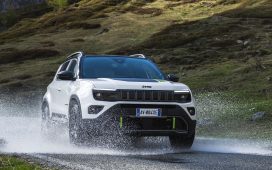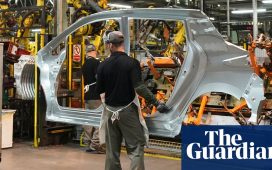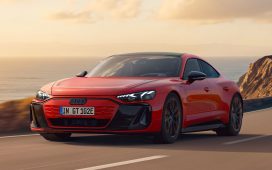Hyundai continues to toil away on its new all-electric seven-seat SUV, the Ioniq 7, ahead of its worldwide debut in 2024. Previewed by the Hyundai Seven concept in 2021, the long-awaited flagship EV will borrow much of its futuristic design language from the existing Ioniq 5 family car and Ioniq 6 saloon, while technical details will closely resemble those of the newly launched Kia EV9.
The test car we’ve snapped out and about in Germany is still covered in heavy camouflage, but can see that the Ioniq 7 has a very bluff front end with a large set of vertical running lights embedded in the bumper and horizontal headlights above them. We expect both light units feature the pixel-style LED design that is a signature of the Ioniq sub-brand’s models. Poking out from behind the camouflage, we can also see some black wheelarch cladding that’s similar to the new Hyundai Kona’s.
Looking at the side profile of the Ioniq 7, we can see its windscreen is steeply raked and the roofline gently slopes towards the rear, unlike the Kia EV9 which is more boxy. That suggests the Ioniq 7’s design will follow more closely in the footsteps of the svelte Ioniq 6 saloon, which should help with the large SUV’s aerodynamics and range, but could impact headroom for those seating in the rearmost seats.
The final car isn’t going to feature such an extreme interior as seen on the original concept, so the rear-opening doors and boldly minimalist design won’t be carried over. Instead, the road-going Ioniq 7 is likely to borrow heavily from the Ioniq 5 and Ioniq 6, including their dual 12.3-inch display setup, but running the brand’s latest software that debuted on the new Kona. Physical buttons and separate climate controls are sure to feature too, while top-spec versions may come with digital wing mirrors, like those found on the Ioniq 6.
The Ioniq 7 will be based on the same E-GMP platform as the Kia EV9, and should be offered with the same combinations of batteries and motors as its fellow seven-seat EV. In the UK, every EV9 is powered by a 99.8kWh battery that feeds either a single 201bhp motor or 379bhp dual-motor setup. The EV9 is capable of covering close to 350 miles on a single charge according to Kia, so we expect the same of the Ioniq 7.
The Ioniq 7 will also benefit from an 800V charging system, which in the EV9 allows for a 10 to 80 per cent top-up in just 24 minutes.
The Ioniq 7 is expected to be one of the last models to use the Hyundai Group’s E-GMP platform, as it was announced last year that the company will introduce the first vehicles based on its next-generation EV platforms, called eM and eS, in 2025.
The eM platform specifically is being developed for electric passenger cars across all segments and will allow for a 50 per cent improvement in driving range on a single charge compared to current models, in addition to supporting Level 3 autonomous driving or higher. The new platform will also utilise the group’s new ‘Integrated Modular Architecture’ with the goal of standardising key components like the battery and electric motors.
Need to sell your car?
Find your best offer from over 5,000+ dealers. It’s that easy.
The eS platform on the other hand is an EV “skateboard” exclusively for Purpose Built Vehicles (PBVs) that will be tailor-made for companies, not consumers.
As for a hot N model, the only Hyundai EV that has an N variant is still the Ioniq 5 N, although we’ve not ruled out an Ioniq 6 N after we saw the radical RN22e concept. The Ioniq 7 probably won’t make an ideal basis of a sporty N car due to its size and weight.
Now read our list of the best electric SUVs currently on sale…










